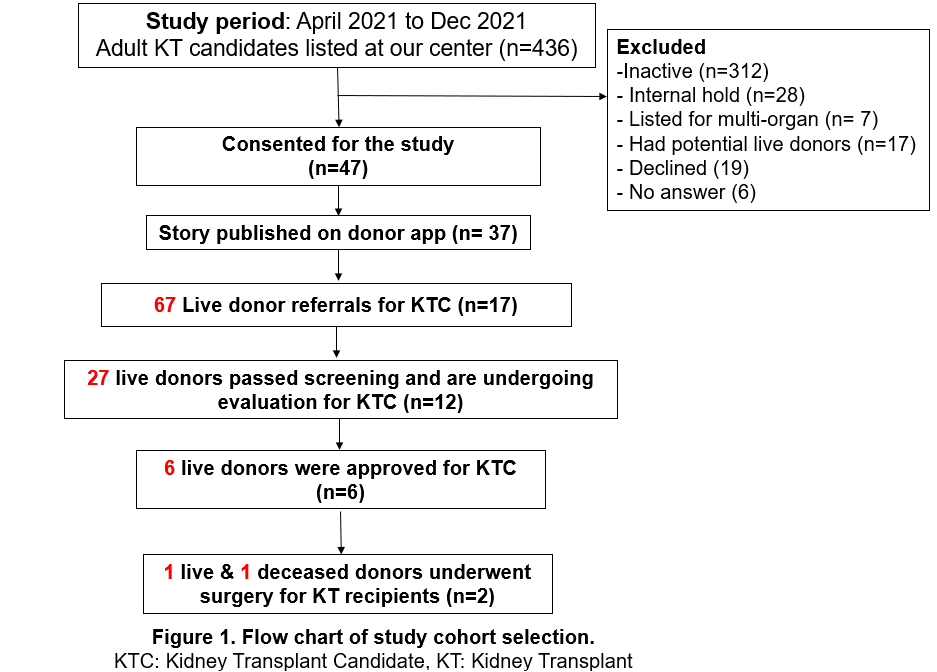Donor App Increases Awareness and Overall Rates of Living Kidney Donation
1Transplant and Hepatobiliary Surgery, Henry Ford Transplant Institute, Detroit, MI, 2Transplant Nephrology, Henry Ford Transplant Institute, Detroit, MI
Meeting: 2022 American Transplant Congress
Abstract number: 492
Keywords: Donation, Kidney, Kidney transplantation, Living donor
Topic: Clinical Science » Kidney » 42 - Kidney Living Donor: Selection
Session Information
Session Name: Kidney Living Donor & Paired Exchange
Session Type: Rapid Fire Oral Abstract
Date: Tuesday, June 7, 2022
Session Time: 5:30pm-7:00pm
 Presentation Time: 5:50pm-6:00pm
Presentation Time: 5:50pm-6:00pm
Location: Hynes Room 302
*Purpose: The rate of living donor kidney transplants (LDKTs) performed has declined overall regardless of race. Studies show that web-based tools increase access to living organ donation (LOD). Kidney transplant candidates (KTCs) may be reluctant to ask potential donors directly. Donor app was designed to help KTCs identify potential living donors by creating social media postings about their need for transplant. The purpose of this study is to evaluate the feasibility of using Donor app in improving awareness about LOD and rates of LDKT.
*Methods: Single center prospective pilot study of 47 adult KTCs without potential donors was conducted using Donor app (Figure 1). KTCs were required to have access to social media account(s) including Facebook, Messenger, Email and/or Twitter. Based on KTC preference, postings were shared on as many platforms as desired. KTCs were allowed to have donor Champion(s) that will post their own story on social media about their relationship with KTC to advocate for donation. Demographics, clinical characteristics, donor referrals and transplant outcomes were compared between KTCs who used the Donor app with 1:1 matched historic controls from our waitlist.
*Results: 37 KTCs posted their stories using the Donor app (Figure 1). Median age 48 yrs (Interquartile range [IQR]: 41.5-58.5 yrs); median time on waitlist 511 days (IQR: 107-777 days), with 54% AA (n=24). Total views on all platforms and patients were 8501. 67 donor referrals came on behalf of 17/37 KTCs (46%) with a median of 6 days (IQR: 1-23 days) from posting to 1st donor inquiry; 5/17 (29%) had at least 1 donor Champion. KTCs with at least 1 donor referral were also likely to have at least 1 donor Champion (p=0.009), use of multiple social media outlets for posting their story (p=0.02), and had significantly higher views vs. ones with no referrals (487 vs. 71 views/KTC respectively; p=0.003). 6/17 (35.2%) had approved donors, of which 3/6 (50%) were AA; to date, 2 underwent transplants (1 LDKT; 1 deceased direct donation) and 4 have approved living donors pending the scheduling of transplant. Another 4 KTC’s have living donors still in evaluation. None of the matched controls had any living donor referrals (p=0.01).
*Conclusions: The Donor app can significantly increase awareness & rate of LOD, including in AA. Transplant programs should consider this technology as adjunct support for KTCs who otherwise have no prospects for potential living kidney donation.
To cite this abstract in AMA style:
Shamaa T, Bajjoka I, Kandalaft H, Prashar R, Callaghan M, Crombez C, Serra SJ, Abouljoud M, Denny J. Donor App Increases Awareness and Overall Rates of Living Kidney Donation [abstract]. Am J Transplant. 2022; 22 (suppl 3). https://atcmeetingabstracts.com/abstract/donor-app-increases-awareness-and-overall-rates-of-living-kidney-donation/. Accessed December 27, 2025.« Back to 2022 American Transplant Congress

